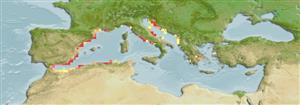Common names from other countries
Classification / Names / Names
Populärnamn | synonymer | Catalog of Fishes (gen., sp.) | ITIS | CoL | WoRMS
Environment: milieu / climate zone / depth range / distribution range
Ekologi
Pelagiska; djupintervall 1 - 50 m (Ref. 3086). Subtropical
Mediterranean: Spain.
Length at first maturity / Size / Vikt / Age
Maturity: Lm ? range ? - ? cm Max length : 7.0 cm COLD hane/ej könsbestämd; (Ref. 3086)
Nematophores present all over fascicled colony, cnidome comprising only microbasic euryteles, especially abundant on nematophore; female blastostyles partially reduced (with some remaining tentacles), spadix unbranched, mature eggs scattered along blastostyle pedicel; male blastostyles completely reduced (Ref. 3086).
Found at depths of 1 to 50 m, generally on rocks. Common in submarine caves and crevices in shallow waters and on rocks in deeper waters (Ref. 3086).
Life cycle and mating behavior
Könsmognad | Reproduktion | Lek | Ägg | Fecundity | Larver
Gonophores were found from February to March and July to October (Ref. 3086).
Marques, A.C., A.L. Peña Cantero and W. Vervoort. 2000. (Ref. 3086)
IUCN Red List Status (Ref. 130435)
CITES status (Ref. 108899)
Not Evaluated
Not Evaluated
Threat to humans
Harmless
Human uses
| FishSource |
Verktyg
Ytterligare information
Age/SizeTillväxtLength-weightLength-lengthMorfologiLarverAbundans
Internet-källor
Estimates based on models
Preferred temperature
(Ref.
115969): 16.2 - 18.5, mean 17.7 (based on 28 cells).
Vulnerability
Low vulnerability (10 of 100).
Price category
Unknown.
